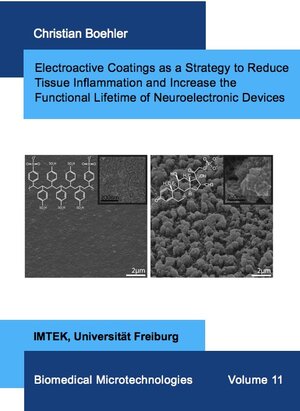
×
![Buchcover ISBN 9783843939775]()
Electroactive Coatings as a Strategy to Reduce Tissue Inflammation and Increase the Functional Lifetime of Neuroelectronic Devices
von Christian BoehlerThis thesis investigates the use of electroactive coatings as a strategy to increase the functional lifetime of neuroelectronic devices. The study is driven by the hypothesis that the longevity of neural probes can be improved by influencing the surface material of the actual recording or stimulation sites on these probes. Drug delivery systems on the basis of conducting polymer films are therefore developed as add-on technology to neural probes, allowing spatially and temporally controlled release of anti-inflammatory drugs directly from the electrode sites. The fundamental characteristics of such thin-film drug delivery systems are evaluated in vitro employing electrochemical and chromatographic analysis methods to investigate the drug loading capacity and to identify efficient release control parameters. Improved longevity for drug-functionalized polyimide probes is furthermore verified in an animal experiment extending over a period of 12 weeks with controlled drug release being performed on a weekly basis.
Next to active drug delivery miniaturization is on its own an essential aspect for improving the tissue integration of neural probes and thereby enabling long-term stable neuroprosthetic applications. A nanostructured platinum coating is thus presented that enables a substantial size reduction as well as an overall improvement in the stimulation and recording performance for the electrode contacts on a neural probe. The nanoPt coating is compared to state of the art electrode materials illustrating the benefit of this material for future longterm stable neuroelectronic device generations.
Next to active drug delivery miniaturization is on its own an essential aspect for improving the tissue integration of neural probes and thereby enabling long-term stable neuroprosthetic applications. A nanostructured platinum coating is thus presented that enables a substantial size reduction as well as an overall improvement in the stimulation and recording performance for the electrode contacts on a neural probe. The nanoPt coating is compared to state of the art electrode materials illustrating the benefit of this material for future longterm stable neuroelectronic device generations.


